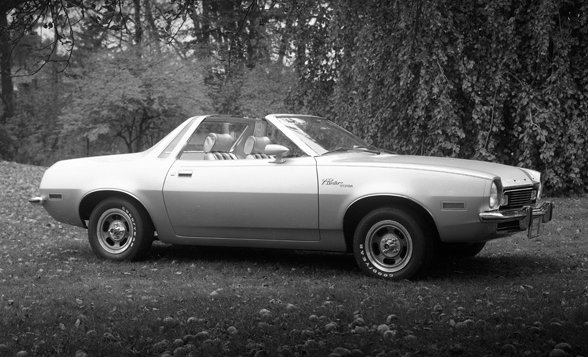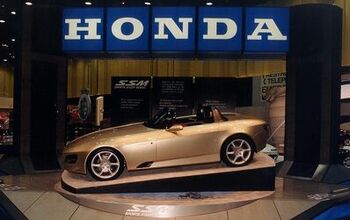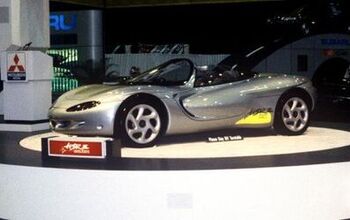The Encyclopedia of Obscure Concept and Show Cars: Part One – Acura to Chevrolet

1973 Ford Pinto Sportiva Concept
Is it a cliche to say that as a writer I try to avoid cliches? Anyway, I do try to avoid the word legendary (see Dash Parr on being special), but some concept and show cars are, well, legendary. Not in the sense, of course, that people tell grand tales about them but because they are remembered, ending up in books and blog posts. Some concept and show cars are, if not the stuff of legends, certainly the stuff of history. Other cars, not so much. For every memorable Cadillac Evoq, Sixteen and Converj, there’s been at least one La Espada or Aurora, cars that never really caught the public or auto enthusiasts’ imagination even if they may have influenced production cars. A concept car can cost an easy million dollars to build, but once that year’s auto show season is over, it’s often forgotten.
For a long time, after they came off the show circuit many show cars were destroyed or otherwise passed out of company hands. They were of no further use to the car companies so they were discarded. Few things become as quickly dated or as passe as last year’s concept cars. After collectors like Joe Bortz and Steve Juliano started finding and restoring those cars, though, car companies have tended to regard show cars as worth saving, if only because of their pecuniary and publicity value, though I think some folks inside the companies do have a clue as to their historic and cultural value. Today I doubt many show vehicles are deliberately destroyed and when they do let concept and show cars slip the bonds of their corporation, car companies try to get maximum value out of the transaction. As part of their centennial celebration a decade ago, in 2002 Ford had Christie’s auction off 50 concept cars from FoMoCo’s corporate collection, with the proceeds going to charity. During GM’s financial crisis and bankruptcy, in 2009 the company culled out 250 prototypes, SEMA show cars, and concepts from their Heritage collection and sold them at the Barrett-Jackson auction in Scottsdale. Since then, car companies have auctioned off a number of other prototypes for publicity and charitable purposes.
While researching Detroit’s legendary (if the shoe fits) Alexander brothers, who built a series of award winning custom cars and also made show cars for Ford in the 1960s, I came across a photo of the 1973 Pinto Sportiva Concept (not an Alexander brothers’ car, though I suppose it’s possible that Larry Alexander may have worked on it as by then he was working for Ford as a master metal modeler in Ford’s prototype shop). It’s a notchback take on the Pinto that presages the Mustang II which was itself based on the Pinto platform, and to make it at least somewhat interesting, Ford gave it a targa roof.
Did you know about the 1973 Ford Pinto Sportiva Concept? Neither did I. How about the 1988 Lincoln Machete? Putting aside the concept car itself for a second, how on Earth did someone at Lincoln think that “Machete” resonated with the Lincoln brand, or with its customers? Those cars got me thinking about obscure concept and show cars so I headed to one of my favorite places to find pics of cool cars from the past, the Chicago Auto Show’s website. The Chicago show has hired professional photographers to shoot the show since at least the early 1950s and they’ve graciously compiled a year by year archive on the show’s website that goes back to the turn of the 20th century. In recent years Robert Shiverts (Oscar & Associates) has been the show’s official photographer. The pics that Shiverts and the other official show photographers have shot over the years are a great historical record of American car culture.
I’ve gone through their dropdown menu of concept cars and picked a few whose names I didn’t really recognize (and a few that I think deserve more attention). Some of them did influence production cars even if they didn’t achieve fame as show cars, others are doubly obscure.
Many of the photos are from the Chicago Auto Show site, but I’ve fleshed out the gallery a bit with some publicity and other archival shots.
Acura’s alphanumeric production car names are hard enough to keep straight. Do you remember the 1995 Acura CL-X concept?
1964 American Motors Rambler Cheyenne Wagon. Western motifs were popular in the ’50s and ’60s, particularly with station wagons.
Also in 1964, AMC showed the Tarpon concept, a great looking fastback based on the compact Rambler American with an almost boattail design. Unfortunately, AMC head Roy Abernethy overruled designer Richard Teague and the roofline ended up on the midsize AMC platform as the Marlin. The proportions didn’t work quite as well. Dodge’s similarly fastback styled but better proportioned Charger outsold the Marlin by a wide margin.
Before there was the Rambler Cheyenne, there was the 1959 Buick Texan, based on the Invicta wagon.
As you can see from the 1958 Buick Wells Fargo, western themes weren’t exclusive to station wagons. The Buick Wells Fargo was made especially for actor Dale Robertson, whose western tv show, Wells Fargo, Buick sponsored.
The 1983 Buick Questor had state of the art electronics, with a laser based keyless entry and a computerized navigation system. That was just two years after IBM introduced the Intel 8088 based 5150 personal computer and the same year two guys named Steve introduced the Apple IIe. Some of the Questor’s electronic features ended up on the production Buick Reatta.
Not to be confused with Brooks Stevens’ masterful Studebaker Sceptre concept, the 1992 Buick Sceptre gave a preview of Buick’s soft curvy design language of the 1990s. It also had one of those newfangled cellular telephones.
They wouldn’t go financially bankrupt until 2009 but General Motors’ creative bankruptcy was evident by 1995. It’s one thing to recycle a concept name, or another to keep a popular car on the show circuit for a couple of years, but reusing the same actual car a dozen years later with virtually no restyling shows that even the famed staff of GM Design didn’t have much left in the tank by the 1990s. In 1995 Buick revived not just the Questor name (companies recycle concept names all the time), it brought back the same car, only with new paint and upgraded electronic gizmos. It’s a little confusing because they recycled the car but by I believe that by 1995 the Questor had 14 micro-computers, automatic level, attitude and spoiler control, a “systems sentinel” to monitor the status of vehicle systems, heads-up display, computer based map and navigation system, automatically aimed headlamps, theft-deterrent system, road traction monitoring and control system, TV rear-view mirror (GM first put a rear facing tv camera on the Centurion Motorama car in the 1950s), and a touch-command system for entertainment, comfort and convenience functions. As a concept car in general, the Questor accurately predicted many of the features on today’s cars. As a concept car to promote the Buick brand, though, it didn’t do much.
1998 Buick Signia station wagon. It’s made some ugliest cars of all time lists but I don’t think it’s that terrible. Okay, on second thought, maybe it is.
1999 Buick Cielo. Remember it? Had Bill Mitchell been alive to see it, I think he would have said that it looked like a fish.
1954 Cadillac La Espada. Actor Ronald Reagan was the Grand Marshall for that year’s Chicago Auto Show. Reagan later rode in Lincolns.
1950 Cadillac Debutante, with all unpainted interior metal plated in gold. In today’s politically correct world, would Cadillac use even fake exotic fur, let alone the Debutante’s real leopard skin?
Cadillac used the Aurora name in 1990. The name would later appear at the top of Oldsmobile’s lineup.
2002 Vizon Concept, a preview of the Cadillac SRX. The Vizon was an early version of Caddy’s Art & Science design theme.
Lately there have been rumors that Chevrolet might expand the Corvette lineup to include a four seater. Expanding the Corvette line is not a new idea. At the 1954 Motorama, Chevy showed hardtop, fastback and station wagon versions of the Corvette, introduced only a year before. For the Motorama in 1957, Chevy debuted the Corvette Impala concept which seated five. Most Motorama cars look a little bizarre to my tastes, but the Corvette Impala was damn near perfect. It’s fate is unknown, probably scrapped.
Did Chevrolet really use the obscure, difficult to pronounce and deliberately misspelled Sigizi in 1992 to introduce the dustbuster minivans? Just what two things are connected sygyzistically in this lozenge shaped vehicle?
Continued tomorrow in part 2, Chrysler to Ford.
Ronnie Schreiber edits Cars In Depth, a realistic perspective on cars & car culture and the original 3D car site. If you found this post worthwhile, you can dig deeper at Cars In Depth. If the 3D thing freaks you out, don’t worry, all the photo and video players in use at the site have mono options. Thanks – RJS

Ronnie Schreiber edits Cars In Depth, the original 3D car site.
More by Ronnie Schreiber
Latest Car Reviews
Read moreLatest Product Reviews
Read moreRecent Comments
- Bd2 Lexus is just a higher trim package Toyota. ^^
- Tassos ONLY consider CIvics or Corollas, in their segment. NO DAMNED Hyundais, Kias, Nissans or esp Mitsus. Not even a Pretend-BMW Mazda. They may look cute but they SUCK.I always recommend Corollas to friends of mine who are not auto enthusiasts, even tho I never owed one, and owned a Civic Hatch 5 speed 1992 for 25 years. MANY follow my advice and are VERY happy. ALmost all are women.friends who believe they are auto enthusiasts would not listen to me anyway, and would never buy a Toyota. They are damned fools, on both counts.
- Tassos since Oct 2016 I drive a 2007 E320 Bluetec and since April 2017 also a 2008 E320 Bluetec.Now I am in my summer palace deep in the Eurozone until end October and drive the 2008.Changing the considerable oils (10 quarts synthetic) twice cost me 80 and 70 euros. Same changes in the US on the 2007 cost me $219 at the dealers and $120 at Firestone.Changing the air filter cost 30 Euros, with labor, and there are two such filters (engine and cabin), and changing the fuel filter only 50 euros, while in the US they asked for... $400. You can safely bet I declined and told them what to do with their gold-plated filter. And when I changed it in Europe, I looked at the old one and it was clean as a whistle.A set of Continentals tires, installed etc, 300 EurosI can't remember anything else for the 2008. For the 2007, a brand new set of manual rec'd tires at Discount Tire with free rotations for life used up the $500 allowance the dealer gave me when I bought it (tires only had 5000 miles left on them then)So, as you can see, I spent less than even if I owned a Lexus instead, and probably less than all these poor devils here that brag about their alleged low cost Datsun-Mitsus and Hyundai-Kias.And that's THETRUTHABOUTCARS. My Cars,
- NJRide These are the Q1 Luxury division salesAudi 44,226Acura 30,373BMW 84,475Genesis 14,777Mercedes 66,000Lexus 78,471Infiniti 13,904Volvo 30,000*Tesla (maybe not luxury but relevant): 125,000?Lincoln 24,894Cadillac 35,451So Cadillac is now stuck as a second-tier player with names like Volvo. Even German 3rd wheel Audi is outselling them. Where to gain sales?Surprisingly a decline of Tesla could boost Cadillac EVs. Tesla sort of is now in the old Buick-Mercury upper middle of the market. If lets say the market stays the same, but another 15-20% leave Tesla I could see some going for a Caddy EV or hybrid, but is the division ready to meet them?In terms of the mainstream luxury brands, Lexus is probably a better benchmark than BMW. Lexus is basically doing a modern interpretation of what Cadillac/upscale Olds/Buick used to completely dominate. But Lexus' only downfall is the lack of emotion, something Cadillac at least used to be good at. The Escalade still has far more styling and brand ID than most of Lexus. So match Lexus' quality but out-do them on comfort and styling. Yes a lot of Lexus buyers may be Toyota or import loyal but there are a lot who are former GM buyers who would "come home" for a better product.In fact, that by and large is the Big 3's problem. In the 80s and 90s they would try to win back "import intenders" and this at least slowed the market share erosion. I feel like around 2000 they gave this up and resorted to a ton of gimmicks before the bankruptcies. So they have dropped from 66% to 37% of the market in a quarter century. Sure they have scaled down their presence and for the last 14 years preserved profit. But in the largest, most prosperous market in the world they are not leading. I mean who would think the Koreans could take almost 10% of the market? But they did because they built and structured products people wanted. (I also think the excess reliance on overseas assembly by the Big 3 hurts them vs more import brands building in US). But the domestics should really be at 60% of their home market and the fact that they are not speaks volumes. Cadillac should not be losing 2-1 to Lexus and BMW.
- Tassos Not my favorite Eldorados. Too much cowbell (fins), the gauges look poor for such an expensive car, the interior has too many shiny bits but does not scream "flagship luxury", and the white on red leather or whatever is rather loud for this car, while it might work in a Corvette. But do not despair, a couple more years and the exterior designs (at least) will sober up, the cowbells will be more discreet and the long, low and wide 60s designs are not far away. If only the interiors would be fit for the price point, and especially a few acres of real wood that also looked real.


















































Comments
Join the conversation
I love the HX concept, though I'm a bit biased...
How about the 1975 Chevy Monza concept named the Super Spyder II that made the show circuit in 1976? http://monza.homestead.com/stiletto.html Kinda slick in my book, but I've always like Monzas. Evidently GM still owns it and it's trotted out every now and then.